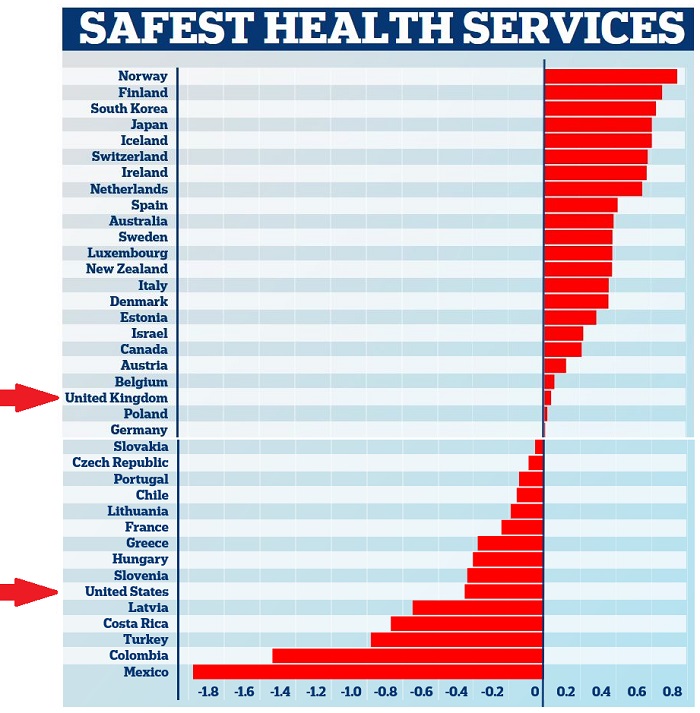…at hospitals anyway, according to some organization:
Researchers at the Institute of Global Health Innovation at Imperial College London examined data on 38 developed countries.
The experts focused on four key patient safety indicators for their rankings: maternal mortality, treatable mortality, adverse effects of medical treatment and neonatal disorders.
For those who are too lazy to follow the link, here’s the table:

Yeah, I know: our hospitals are ranked lower because we take on more hopeless cases than most other countries will accept. (Whenever you read about some Third-World mope who needs to have the extra toes growing out of his neck removed, it’s always off to the U.S. and not to Sweden, because they just won’t take the case.)
I also note with some skepticism the high rank of the Netherlands, which is the absolute last place where I’d go to hospital because of the Dutchies’ fondness for involuntary euthanasia.
Finally, not being of a medical bent myself, I have no idea whether the criteria of “maternal mortality, treatable mortality, adverse effects of medical treatment and neonatal disorders” are the best pointers towards judgement of hospital quality; I’ll leave that to my Sawbones Readers to comment on.

A critical metric they do not examine at all is time delay between diagnosis and treatment. Most of these government run “healthcare” schemes fail miserably on that metric.
You don’t even have to look at third world genetic anomalies for there destination to have medical procedures performed. Look at folks like Mick Jagger. He could have stayed in England to have his heart condition treated. Instead he came to the United States for his cardiac surgery.
Also, look at the R&D side of things. The United States leads the world by leaps and bounds with innovative treatment.
JQ
Here in the UK – I cannot speak for other countries – the general rule is that if you require immediate critical care you will get it but if you can wait you may be asked to do so (because someone else may require immediate critical care). You can also purchase private healthcare so you don’t have to wait. There are only so many surgeons, doctors, hospitals, etc so it’s a limited resource.
There are huge discrepancies in how the data is categorized in various countries. Of particular note is that most (all?) European countries exclude much negative data for various reasons and this is not done in the US. This is not actually a problem if done consistently, but requires re-norming the data before comparing.
There you go again, applying rigorous research techniques and spoiling the Narrative.
Two of the four, maternal mortality and neonatal disorders, deal with rather specific stages of life. I don’t think those categories would have much affect on heart bypass procedures or appendectomies.
It’s also a mattern of definition. For neonatal mortality, in the US a birth before a certain point, if the baby is alive, counts as a live birth and the baby is treated. Almost always ending in an infant mortality. In other places is chalked up as a miscarriage even if the baby is alive, no treatment happens, and it’s not counted as a mortality.
Mark D
JAPAN? Japan comes in 4th in patient safety?
I don’t buy it. Not for one second.
Japan has total 5th world hospitals. My mom stayed in one for months (during which they completely misdiagnosed and mishandled her case) in the early 90’s.The places were septic; taxis were cleaner.
Protip: if you need surgery in Japan, insist they perform it in the back of a taxi.